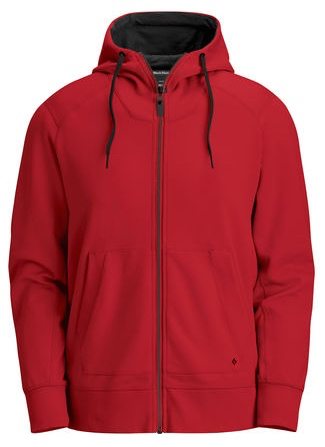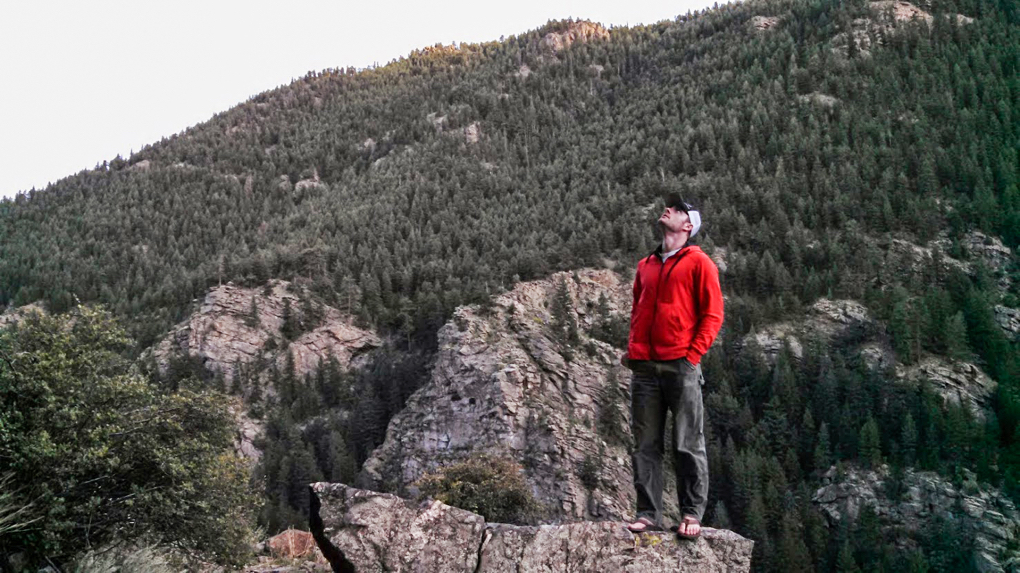
Black Diamond Deployment Hoody
Reviewer: 6’3”, 185 lbs
Size: Large
Stated Weight: 630 grams (1 lb 6.2 oz)
Blister’s Measured Weight: 600 grams
Features:
- Adjustable hood
- Two hand pockets
- Wool rib hem and cuffs
- Blended merino wool (300 g/m2, 60% merino wool, 40% nylon)
MSRP: $200
Locations Tested: Rocky Mountain National Park, CO; UT Desert; Wyoming; Yosemite, CO; All over Colorado in both the outdoors and around town
Days Worn: 40
Black Diamond’s Deployment hoody is a full-zip hoodie that serves as a technical mid layer and as a casual layer, typically referred to as a “lifestyle” article.
The fabric, a 60/40 Merino wool/nylon blend, is appropriate for this sort of use. Both materials are well-suited for outdoor use, while also looking good around town.
Fit
When it comes to the fit, things get a little tricky. On one hand, you want the hoody trim enough that you can comfortably wear it under a shell in the mountains. On the other hand, it needs to be relaxed enough for everyday use. The Deployment hoody strikes this balance fairly well.
I’m 6’3”, so a bit toward the taller end of the scale, but with a fairly average build otherwise. The Large Deployment hoody definitely suits both purposes well for me in terms of fit, and also fits true to size. It’s not too long; I can still wear it under a harness without pulling it out from under the waist belt every time I reach for a high hold, but just barely. Ditto for the sleeves – another inch on the sleeves would definitely be helpful for taller folks like myself. I’ll readily admit that this is a height dependent problem, but it’s one that I don’t have with my Patagonia R1 hoody.
(For another point of reference, Blister’s editor, Jonathan Ellsworth, has also been using the Deployment Hoody in a size Large, so he’s going to chime in a bit here. He’s 5’10”, ~180 lbs., and finds the fit to be on point—not too long, sleeve length is good even when hunched over a bike, etc.)
While the fit of the Deployment hoody is relatively slim and performance-oriented, it’s not as functional as form-fitting base layers, be they wool or synthetic. If you’re looking for something strictly for active use in the outdoors, you’re likely better off with something like an R1 (if you’re indifferent to the material), or a midlayer like Icebreaker’s Quantum Long Sleeve Hoodie if you’re looking for wool.
Fabric and Performance
The Deployment’s fabric takes most of its feel from the wool, but has a tight, fine weave that differentiates it from thicker, loftier wool hoodies or sweaters. This tight weave keeps the volume down for when you need to pack it, and helps keep snags to a minimum. That said, I still did manage to snag a thread in the back of my Deployment hoody (likely the result of the hoody sharing intimate pack space with my trad gear on more than one occasion…).
As you might expect, then, the Deployment hoody lags behind these thicker layers in terms of warmth. This is a sacrifice for cold days around town when you probably want more warmth from a single layer. But it’s more in line with what essentially functions as part of a small handful of layers one might take climbing in different circumstances.

Over the course of the past summer, I got in some solid days in the alpine in the Deployment hoody, predominantly in Rocky Mountain National Park. I also wore it in some lower-elevation areas such as the South Platte and Lumpy Ridge in Colorado, or Ten Sleep in Wyoming, where I occasionally needed an insulating layer, too; the Deployment by itself was not quite warm enough.
In some of the higher elevations in Rocky Mountain National Park, winter never fully recedes, and even in the summer, long days in the park generally start in the cool pre-dawn. For these colder mornings, the Deployment hoody was comfortable to hike in, though not so warm as to be comfortable milling about when temps are near freezing.
The Deployment hoody did a good job wicking moisture when I did start to sweat, in part because of the hydrophobic nylon, and wool’s abilities to retain insulation in the presence of sweat.
(Jonathan’s take: I’ve got about 50 days in the Deployment Hoody, and have used it primarily as a casual piece or as a midlayer when resort skiing on warmer days. Dave’s right: this is not a super warm hoody, but more of a low-bulk hoody that has worked well for me in the 45-60 F range in the resort, with plenty of short, high-output bootpacks between 11,000-12,000 feet. I typically wore it over a long-sleeve midweight wool baselayer, and beneath the FlyLow LabCoat 2.0. And I agree with Dave: the Deployment Hoody does a good job of wicking moisture.)
Features and Price
The Deployment hoody lacks small technical features that midlayers like the Patagonia R1 or the Mons Royale Mid Hoodie have, such as thumb loops on the sleeves. I’ve always found that thumb loops are helpful when using your full range of motion, like when reaching for a high hold.
As I mentioned earlier, however, the Deployment hoody isn’t really trying to fill the same niche as most of these other pieces: it’s explicitly a crossover piece of gear, which is key when considering it. With a $200 price tag, it’s not as pricey as the most expensive Merino midlayers; high quality wool simply isn’t cheap.
That said, the Deployment hoody is 40% nylon, which somewhat undercuts its value relative to 98% wool articles like the Icebreaker midlayer I mentioned. Ultimately, the price tag is more or less in line with what you would expect for the materials: more expensive than all-synthetic options like the R1, less expensive than 100% merino.
The value for each person, then, depends heavily on your material preferences and whether or not you’re actually going to use it both outdoors and around town.
Bottom Line
If you’re just looking for something to wear under a hardshell when you’re working hard in the mountains, then you’re probably better with something like an R1, and using your crappy old cotton hoody for sitting around the campfire.
But, if you want one midlayer to have on hand both for active use as well as sitting around the campfire, then the Deployment hoody is very competitive relative to other midlayers out there.
